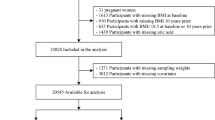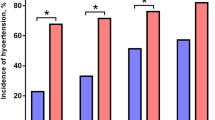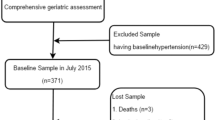Abstract
Hypertension is a large and growing public health problem worldwide. Hyperuricemia and overweight/obesity are two of the most important risk factors for hypertension. However, their combined effect on the risk of hypertension is not known. Participants aged 20 years and older from the National Health and Nutrition Examination Survey from 1999–2012 were used to evaluate the separate and combined effects of hyperuricemia and overweight/obesity on the risk of prevalent hypertension among different race, gender and age groups. Participants (31 473) were used to estimate separate and combined effects on the prevalence of hypertension. The overall prevalence of hypertension among adults with a combination of hyperuricemia and overweight/obesity (50.2%, 95% confidence interval (CI) 48.3–52.1%) was significantly higher than separate hyperuricemia (41.7%, 95% CI 37.2–46.2%) and overweight/obesity (30.6%, 95% CI 29.5–31.8%). The magnitude of odds ratio (OR) from the combination of hyperuricemia and overweight/obesity (OR=4.53, 95% CI 4.05–5.07) was significantly higher than both hyperuricemia (OR=2.62, 95% CI 2.07–3.32) and overweight/obesity (OR=2.08, 95% CI 1.89–2.30). Combined effect of hyperuricemia and overweight/obesity on the risk of hypertension is much stronger than any separate one. These data can provide important information for identification of target populations for future intervention and patient management.
This is a preview of subscription content, access via your institution
Access options
Subscribe to this journal
Receive 12 digital issues and online access to articles
$119.00 per year
only $9.92 per issue
Buy this article
- Purchase on SpringerLink
- Instant access to full article PDF
Prices may be subject to local taxes which are calculated during checkout
Similar content being viewed by others
References
Centers for Disease Control and Prevention (CDC). Vital signs: prevalence, treatment, and control of hypertension—United States, 1999–2002 and 2005-2008. MMWR 2011; 60: 103–108.
Farley TA, Dalal MA, Mostashari F, Frieden TR . Deaths preventable in the US by improvements in use of clinical preventive services. Am J Prev Med 2010; 38: 600–609.
Kearney PM, Whelton M, Reynolds K, Muntner P, Whelton PK, He J . Global burden of hypertension: analysis of worldwide data. Lancet 2005; 365: 217–223.
Chockalingam A, Campbell NR, Fodor JG . Worldwide epidemic of hypertension. Can J Cardiol 2006; 22: 553–555.
Mazzali M, Hughes J, Kim YG, Jefferson JA, Kang DH, Gordon KL et al. Elevated uric acid increases blood pressure in the rat by a novel crystal-independent mechanism. Hypertension 2001; 38: 1101–1106.
Mazzali M, Kanellis J, Han L, Feng L, Xia YY, Chen Q et al. Hyperuricemia induces a primary renal arteriolopathy in rats by a blood pressure independent mechanism. Am J Physiol Renal Physiol 2002; 282: F991–F997.
Johnson RJ, Feig DI, Herrera-Acosta J, Kang DH . Resurrection of uric acid as a causal risk factor in essential hypertension. Hypertension 2005; 45: 18–20.
Mahomed FA . On chronic Bright’s disease, and its essential symptoms. Lancet 1879; 1: 399–401.
Nagahama K, Inoue T, Iseki K, Touma T, Kinjo K, Ohya Y et al. Hyperuricemia as a predictor of hypertension in a screened cohort in Okinawa, Japan. Hypertens Res 2004; 27: 835–841.
Soletsky B, Feig DI . Uric acid reduction rectifies prehypertension in obese adolescents. Hypertension 2012; 60: 1148–1156.
Kotchen TA . Obesity-related hypertension?: weighing the evidence. Hypertension 2008; 52: 801–802.
Segal-Lieberman G, Rosenthal T . Animal models in obesity and hypertension. Curr Hypertens Rep 2013; 15: 190–195.
Mangge H, Zelzer S, Puerstner P, Schnedl WJ, Reeves G, Postolache TT et al. Uric acid best predicts metabolically unhealthy obesity with increased cardiovascular risk in youth and adults. Obesity (Silver Spring) 2013; 21: E71–E77.
Ishiro M, Takaya R, Mori Y, Takitani K, Kono Y, Okasora K et al. Association of uric acid with obesity and endothelial dysfunction in children and early adolescents. Ann Nutr Metab 2013; 62: 169–176.
Krzystek-Korpacka M, Patryn E, Kustrzeba-Wojcicka I, Chrzanowska J, Gamian A, Noczynska A . The effect of a one-year weight reduction program on serum uric acid in overweight/obese children and adolescents. Clin Chem Lab Med 2011; 49: 915–921.
Ogden CL, Carroll MD, Kit BK, Flegal KM . Prevalence of obesity in the United States, 2009–2010, NCHS data brief, no 82 National Center for Health Statistics: Hyattsville, MD, USA, 2012.
Viazzi F, Antolini L, Giussani M, Brambilla P, Galbiati S, Mastriani S et al. Serum uric acid and blood pressure in children at cardiovascular risk. Pediatrics 2013; 132: e93–e99.
Komiya I, Yamada T, Takasu N, Asawa T, Akamine H, Yagi N et al. An abnormal sodium metabolism in Japanese patients with essential hypertension, judged by serum sodium distribution, renal function and the renin-aldosterone system. J Hypertens 1997; 15: 65–72.
Centers for Disease Control and Prevention (CDC). The Third National Health and Nutrition Examination Survey (NHANES III 1988–94) reference manuals and reports [CD-ROM]. National Center for Health Statistics: Hyattsville, MD, USA, 1996.
Feig DI . Hyperuricemia and hypertension. Adv Chronic Kidney Dis 2012; 19: 377–385.
Sundström J, Sullivan L, D'Agostino RB, Levy D, Kannel WB, Vasan RS . Relations of serum uric acid to longitudinal blood pressure tracking and hypertension incidence. Hypertension 2005; 45: 28–33.
Hollister LE, Overall JE, Snow HL . Relationship of obesity to serum triglyceride, cholesterol, and uric acid and to plasma-glucose levels. Am J Clin Nutr 1967; 20: 777–782.
Krizek U . Serum uric acid in relation to body weight. Ann Rheum 1966; 25: 456–458.
Juraschek SP, Miller ER 3rd, Gelber AC . Body mass index, obesity, and prevalent gout in the United States in 1988–1994 and 2007–2010. Arthritis Care Res (Hoboken) 2013; 65: 127–132.
Tsushima Y, Nishizawa H, Tochino Y, Nakatsuji H, Sekimoto R, Nagao H et al. Uric acid secretion from adipose tissue and its increase in obesity. J Biol Chem 2013; 288: 27138–27149.
Yamashita S, Matsuzawa Y, Tokunaga K, Fujioka S, Tarui S . Studies on the impaired metabolism of uric acid in obese subjects: Marked reduction of renal urate excretion and its improvement by a low-calorie diet. Int J Obes 1986; 10: 255–264.
Stolarz-Skrzypek K, Bednarski A, Czarnecka D, Kawecka-Jaszcz K, Staessen JA . Sodium and potassium and the pathogenesis of hypertension. Curr Hypertens Rep 2013; 15: 122–130.
Zhang Z, Cogswell ME, Gillespie C, Fang J, Loustalot F, Dai S et al. Association between usual sodium and potassium intake and blood pressure and hypertension among US adults: NHANES 2005-2010. PLoS ONE 2013; 8: e75289.
Briasoulis A, Agarwal V, Messerli FH . Alcohol consumption and the risk of hypertension in men and women: a systematic review and meta-analysis. J Clin Hypertens (Greenwich) 2012; 14: 792–798.
Jung JG, Kim JS, Kim YS, Oh MK, Yoon SJ . Hypertension associated with alcohol consumption based on the facial flushing reaction to drinking. Alcohol Clin Exp Res 2013; 38 (4): 1020–1025.
Borghi C, Veronesi M, Bacchelli S, Esposti DD, Cosentino E, Ambrosioni E . Serum cholesterol levels, blood pressure response to stress and incidence of stable hypertension in young subjects with high normal blood pressure. J Hypertens 2004; 22: 265–272.
Liu X, Wang K, Lee K . Association of standardized estimated glomerular filtration rate with the prevalence of hypertension among adults in the United States. J Hum Hypertens 2011; 25: 469–475.
Zhu Y, Pandya BJ, Choi HK . Prevalence of gout and hyperuricemia in the US general population: the National Health and Nutrition Examination Survey 2007-2008. Arthritis Rheum 2011; 63: 3136–3141.
Feig DI, Soletsky B, Johnson RJ . Effect of allopurinol on blood pressure of adolescents with newly diagnosed essential hypertension: a randomized trial. JAMA 2008; 300: 924–932.
Whelton A . Hyperuricemia and hypertension: a confluence of concepts. Hypertension 2012; 60: 1112–1113.
Gutiérrez-Macías A, Lizarralde-Palacios E, Martínez-Odriozola P, Miguel-De la Villa F . Fatal allopurinol hypersensitivity syndrome after treatment of asymptomatic hyperuricaemia. BMJ 2005; 331: 623–624.
Author information
Authors and Affiliations
Corresponding author
Ethics declarations
Competing interests
The authors declare no conflict of interest.
Rights and permissions
About this article
Cite this article
Han, GM., Gonzalez, S. & DeVries, D. Combined effect of hyperuricemia and overweight/obesity on the prevalence of hypertension among US adults: result from the National Health and Nutrition Examination Survey. J Hum Hypertens 28, 579–586 (2014). https://doi.org/10.1038/jhh.2014.31
Received:
Revised:
Accepted:
Published:
Issue date:
DOI: https://doi.org/10.1038/jhh.2014.31
This article is cited by
-
Excess serum uric acid is associated with metabolic syndrome in obese adolescent patients
Journal of Diabetes & Metabolic Disorders (2020)
-
High prevalence of obesity-related hypertension among adults aged 40 to 79 years in Southwest China
Scientific Reports (2019)



